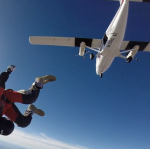-
Content
5 -
Joined
-
Last visited
Never -
Feedback
N/A
Community Reputation
0 NeutralGear
-
Main Canopy Size
170
-
Reserve Canopy Size
193
-
AAD
Cypres 2
Jump Profile
-
Home DZ
Skydive Elsinore
-
License
D
-
License Number
36287
-
Licensing Organization
USPA
-
Number of Jumps
777
-
Tunnel Hours
5
-
Years in Sport
2
Ratings and Rigging
-
USPA Coach
Yes
-
I was in the same position as you when I had about 100 jumps on my Swift 2. I got a Freak, did about 30 jumps on it, and went back to my Swift 2 for the past 100+ WS jumps. I'm now bouncing back and forth between the two with significantly more respect for what both suits are capable of. I wasn't ready for the Freak, you might be, but I thought I was and definitely wasn't. The second 100 WS jumps were eye opening as to what I could still learn in the smaller suit without the legitimate risks associated with a larger suit. The exits and deployments are different. The deflection point in the small suit is kinda fun, it can be scary in a bigger suit. High speed stalls in a big suit get funky quickly, you barely notice them in a small suit. I got into a few hairy situations that I should have been able to handle better. I got away with things and I'm still here. I managed to have just one cutaway in the Freak (I know 1 out of 30 is ridiculous but I've seen a lot worse ratios). If you exit perfectly and fly straight lines at moderate angles you will be fine. Your deployments may or may not be weird depending on how much you decide to play around with different airspeed modulation techniques. If you do everything right but someone still runs into you or something, and you over compensate and get yourself into a new situation, you will find out it is a bit different than those instabilities in your Swift 1. Remember when you downsized from a 260 to a 220 and couldn't do all the things that used to be easy: http://www.dropzone.com/cgi-bin/forum/gforum.cgi?post=4804520;#4804520? Well the Swift 1 is to the Freak 2 like a 260 is to a 135. The ATC is like a 170 in that analogy. As an aside, the Swift 1 is a fair bit less performant than the Swift 2. So you might just be wanting something faster, but not really needing to go all the way to a "big" suit. In that case, you will get everything you are probably looking to get out of the Freak 2 by getting the ATC. Personally I would have gotten an ATC if it existed when I bought my Freak.
-
I come for the articles but I stay for the comments
-
I have a Vector V354 and I was looking at http://www.unitedparachutetechnologies.com/PDF/CHART_00037___Rig_Sizing_Chart.pdf as a guide for what canopies could fit in it (see page 8). The part that confuses me is comparing the V353 to the V354. The Standard and Full fitting examples for the two containers are basically identical except for the reserve sizes where it looks like the V354 is a bit smaller than the V353. However, for the Loose fitting examples, the V353 lists no reserves and the V354 lists no mains. My real query is whether I can safely put a Storm 170 into a V354. It shows it would be loose fitting in the V353, but I am left wondering about the V354. I understand the big issue with too loose of a fit is improper pin tension. Can someone elaborate how the extra 1" in Length but 3/4" less of thickness equates to no loose fitting mains? Should I just borrow a 170, put it in, and see how tight/loose the pin is? Is there a good way to test that other than getting a rigger to look at it and trust their judgement? I asked a rigger vaguely about this and he said it is possible to sew in a small "pillow" to get the smaller size main to fit more snugly if a new container is completely out of the question for some reason. I would rather not go that route if possible.
-
To go even further along these lines, your particular equipment will also influence how you deal with certain malfunctions, line twists being the primary one that I can think of. As a student, on a Navigator 260, pulling at 5500, you can probably kick out of even severe line twists (while maintaining altitude awareness) without any real issues. On a Comp Velo 84 pulling at 3000, you are probably going to chop line twists right away. That being said, when you are jumping that equipment you have the experience to evaluate the situation. When you look for information on the internet, people will usually have their own built-in biases as to how they deal with situations based on their own equipment and experience. Seeking the advice of your instructors is therefore best. Even asking people around the dropzone can be dicey because they might consider 1500 to be their hard deck whilst you are more comfortable with 2000 or 2500. Hence, make sure you are taking into account all of the variables that could affect your decision when coming up with your plan. Continue to evaluate your response to malfunctions anytime you jump a different piece of equipment as well.
-
As a new skydiver, I read "People fly landing patterns" and thought man I'm glad I wasn't born 30 years ago.


